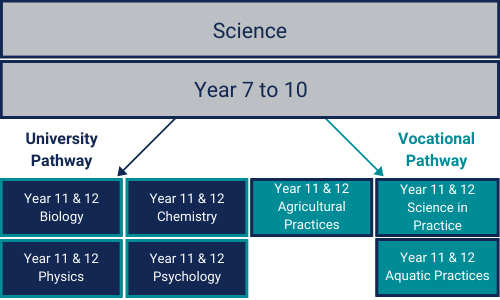Prerequisites
Minimum Level of Achievement required:
- General Science B result
- English C result, and
- General Mathematics B result
Corequisites
Mathematical Methods, General English
Subject Description
Physics provides opportunities for students to engage with classical and modern understandings of the universe. Students learn about the fundamental concepts of thermodynamics, electricity and nuclear processes; and about the concepts and theories that predict and describe the linear motion of objects. Further, they explore how scientists explain some phenomena using an understanding of waves. They engage with the concept of gravitational and electromagnetic fields, and the relevant forces associated with them. They study modern physics theories and models that, despite being counterintuitive, are fundamental to our understanding of many common observable phenomena.
Weekly workload in hours
4+ hours
Structure
Thermal, nuclear and electrical physics
| Linear motion and waves
| Gravity and electromagnetism
| Revolutions in modern physics
|
Topic 1
Ionising radiation and nuclear reactions
|
Topic 1
Linear motion and force
|
Topic 1
Gravity and motion
|
Topic 1
Special relativity
|
Topic 2
Properties and structure of materials
|
Topic 2
Waves
|
Topic 2
Electromagnetism
|
Topic 2
Quantum theory
|
Topic 3
Electrical circuits
|
|
| Topic 3
The Standard Model
|
Assessment
Schools devise assessments in Units 1 and 2 to suit their local context. In Units 3 and 4 students complete four summative assessments. The results from each of the assessments are added together to provide a subject score out of 100. Students will also receive an overall subject result (A–E).
Assessment
Formative internal assessment 1 (FA1): Data test
| 10% | Formative internal assessment 3 (FA3): Research investigation | 20% |
Formative internal assessment 2 (FA2): Student experiment
| 20% |
Formative internal assessment (FA3): 50%
Examination
|
Summative internal assessment 1 (IA1): Data test
| 10% | Summative internal assessment 3 (IA3): Research investigation | 20% |
Summative internal assessment 2 (IA2): Student experiment
| 20% |
Summative external assessment (EA): 50%
Examination |
